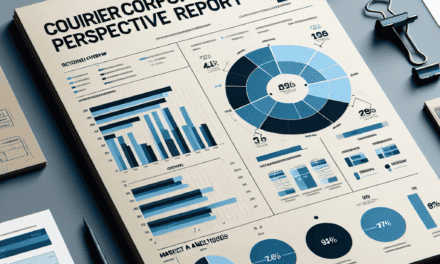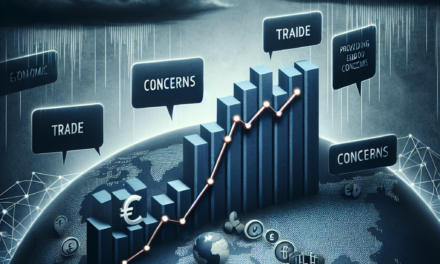“Equity Futures Steady: Navigating Rate Reassessment with Confidence”
Introduction
Equity futures remained stable as investors reassessed the likelihood of future interest rate cuts, reflecting a cautious market sentiment. This steadiness comes amid a backdrop of economic data releases and central bank communications that have prompted market participants to recalibrate their expectations regarding monetary policy adjustments. The reassessment follows recent signals from policymakers suggesting a more measured approach to rate cuts, balancing concerns over inflationary pressures with the need to support economic growth. As a result, traders and analysts are closely monitoring upcoming economic indicators and central bank meetings for further guidance, contributing to the current equilibrium in equity futures.
Understanding Equity Futures: A Steady Market Amid Rate Cut Reassessments
Equity futures have recently demonstrated a remarkable steadiness, even as investors and analysts reassess the likelihood of future rate cuts by central banks. This stability in the futures market reflects a complex interplay of factors that are influencing investor sentiment and market dynamics. To understand this phenomenon, it is essential to delve into the underlying reasons for the current market behavior and the broader economic context in which these developments are occurring.
Initially, the anticipation of rate cuts by central banks, particularly the Federal Reserve, had fueled optimism among investors, leading to a buoyant equity market. Lower interest rates generally reduce the cost of borrowing, thereby encouraging investment and spending, which can stimulate economic growth. Consequently, the prospect of rate cuts often leads to increased demand for equities, as investors seek higher returns in a low-interest-rate environment. However, recent economic data and statements from central bank officials have prompted a reassessment of the likelihood and timing of such rate cuts.
One of the primary factors contributing to this reassessment is the resilience of the global economy, which has shown signs of strength despite ongoing challenges. For instance, labor markets in several major economies have remained robust, with low unemployment rates and steady job creation. Additionally, consumer spending has continued to be a driving force, supported by rising wages and strong consumer confidence. These positive indicators suggest that the economy may not require immediate monetary easing, leading investors to recalibrate their expectations regarding rate cuts.
Moreover, inflationary pressures have also played a significant role in shaping market expectations. While inflation has been relatively subdued in recent years, there are emerging signs of upward pressure on prices. Factors such as supply chain disruptions, rising commodity prices, and increased demand for goods and services have contributed to this trend. Central banks, therefore, face the challenge of balancing the need to support economic growth with the imperative to keep inflation in check. This delicate balancing act has led to a more cautious approach to rate cuts, further influencing investor sentiment.
In this context, equity futures have held steady as market participants weigh these various factors. The stability of futures contracts reflects a broader consensus that, while rate cuts may not be imminent, the underlying economic fundamentals remain relatively strong. Investors appear to be adopting a wait-and-see approach, maintaining their positions while closely monitoring economic indicators and central bank communications for further guidance.
Furthermore, the global nature of financial markets means that developments in one region can have ripple effects across others. For example, policy decisions by the European Central Bank or the Bank of Japan can influence investor behavior in the United States and vice versa. This interconnectedness adds another layer of complexity to the market dynamics, as participants must consider a wide range of factors when making investment decisions.
In conclusion, the steadiness of equity futures amid the reassessment of rate cuts underscores the nuanced and multifaceted nature of financial markets. While the prospect of immediate monetary easing has diminished, the resilience of the global economy and the ongoing evaluation of inflationary pressures continue to shape investor expectations. As market participants navigate this evolving landscape, the interplay of economic data, central bank policies, and global developments will remain key determinants of future market trends.
The Impact of Rate Cut Reassessments on Equity Futures
In recent weeks, equity futures have demonstrated a remarkable steadiness, reflecting a broader market sentiment that is cautiously optimistic yet vigilant. This stability comes amid a reassessment of potential rate cuts by central banks, a factor that has historically influenced market dynamics significantly. As investors and analysts recalibrate their expectations, the interplay between monetary policy and market performance becomes increasingly intricate.
The anticipation of rate cuts often serves as a catalyst for market movements, as lower interest rates typically reduce borrowing costs, stimulate economic activity, and enhance corporate profitability. Consequently, the prospect of rate cuts can lead to bullish sentiment in equity markets. However, the current environment presents a more nuanced picture. While some market participants had initially anticipated aggressive rate cuts to counteract economic headwinds, recent economic data and central bank communications have prompted a reevaluation of these expectations.
Central banks, particularly the Federal Reserve, have signaled a more measured approach to monetary policy adjustments. This shift is largely driven by a complex set of factors, including persistent inflationary pressures, labor market dynamics, and geopolitical uncertainties. As a result, the likelihood of immediate and substantial rate cuts has diminished, leading investors to reassess their strategies and expectations.
In this context, equity futures have maintained a steady course, reflecting a market that is neither overly exuberant nor excessively cautious. This equilibrium suggests that investors are weighing the potential benefits of rate cuts against the risks of inflation and other macroeconomic challenges. Moreover, the steadiness in equity futures indicates a level of confidence in the resilience of corporate earnings and the broader economy, even in the absence of aggressive monetary easing.
Transitioning to the implications of this reassessment, it is essential to consider the broader economic landscape. The global economy is navigating a period of transition, characterized by shifting supply chains, evolving consumer behaviors, and technological advancements. These factors, coupled with the ongoing impact of geopolitical tensions, create a complex backdrop for monetary policy decisions. As central banks strive to balance growth and stability, their cautious stance on rate cuts reflects an acknowledgment of these multifaceted challenges.
Furthermore, the reassessment of rate cuts underscores the importance of data-driven decision-making in monetary policy. Central banks are increasingly reliant on real-time economic indicators to guide their actions, emphasizing the need for flexibility and adaptability in a rapidly changing environment. This data-centric approach is mirrored in the behavior of market participants, who are closely monitoring economic releases and central bank communications to inform their investment strategies.
In conclusion, the steadiness of equity futures amid the reassessment of rate cuts highlights a market that is navigating a complex and evolving landscape with prudence and foresight. While the prospect of immediate rate cuts has diminished, the underlying economic fundamentals and corporate resilience continue to support a stable market outlook. As investors and policymakers alike adapt to this new reality, the interplay between monetary policy and market performance will remain a focal point of analysis and discussion. This dynamic underscores the importance of vigilance and adaptability in an era marked by uncertainty and transformation.
Market Stability: How Equity Futures Hold Steady
In recent weeks, the financial markets have been characterized by a notable steadiness in equity futures, a development that has captured the attention of investors and analysts alike. This stability comes amid a broader reassessment of potential interest rate cuts by central banks, a factor that has historically influenced market volatility. As market participants navigate this complex landscape, understanding the underlying dynamics that contribute to the current equilibrium in equity futures becomes essential.
To begin with, the anticipation of interest rate cuts has been a significant driver of market sentiment. Central banks, particularly in major economies, have been closely monitoring economic indicators to determine the appropriate monetary policy stance. Initially, there was widespread speculation that rate cuts would be imminent, driven by concerns over slowing economic growth and geopolitical uncertainties. However, recent economic data has painted a more nuanced picture, leading to a reassessment of the likelihood and timing of such monetary policy adjustments.
In this context, equity futures have demonstrated remarkable resilience. One of the key factors contributing to this steadiness is the robust performance of corporate earnings. Despite the macroeconomic challenges, many companies have reported better-than-expected earnings, bolstered by strong consumer demand and effective cost management strategies. This has provided a solid foundation for equity markets, instilling confidence among investors and mitigating the impact of external uncertainties.
Moreover, the diversification of investment portfolios has played a crucial role in maintaining market stability. Investors have increasingly sought to balance their exposure across different asset classes, thereby reducing the potential for sharp fluctuations in equity futures. This strategic allocation has been supported by a growing recognition of the importance of risk management in an unpredictable economic environment. As a result, the market has been able to absorb shocks more effectively, contributing to the observed steadiness.
Additionally, the role of technology and innovation cannot be overlooked in this context. The rapid advancement of financial technology has facilitated more efficient trading and risk assessment, enabling market participants to respond swiftly to changing conditions. This has enhanced market liquidity and reduced the likelihood of abrupt disruptions, further supporting the stability of equity futures.
Furthermore, geopolitical developments have also influenced market dynamics, albeit in a more subdued manner than initially anticipated. While tensions in various regions continue to pose potential risks, diplomatic efforts and negotiations have provided a degree of reassurance to investors. This has allowed markets to focus more on fundamental economic indicators rather than being swayed by short-term geopolitical events.
In conclusion, the steadiness of equity futures amid the reassessment of rate cuts reflects a confluence of factors that have collectively contributed to market stability. The interplay between corporate earnings, portfolio diversification, technological advancements, and geopolitical considerations has created an environment where equity futures can hold steady despite the uncertainties that loom on the horizon. As investors continue to navigate this landscape, maintaining a keen awareness of these dynamics will be crucial in making informed decisions. Ultimately, the ability of equity futures to remain stable in the face of potential rate cuts underscores the resilience of financial markets and their capacity to adapt to evolving economic conditions.
Analyzing the Resilience of Equity Futures in a Volatile Market

In recent weeks, equity futures have demonstrated remarkable resilience, maintaining a steady course even as investors reassess the likelihood of imminent rate cuts by central banks. This stability in the futures market is noteworthy, particularly given the volatile economic landscape characterized by fluctuating inflation rates, geopolitical tensions, and varying economic data. As market participants navigate these complexities, the steadiness of equity futures suggests a cautious optimism about the future trajectory of the global economy.
To understand this resilience, it is essential to consider the broader context in which these futures are operating. Initially, expectations of rate cuts were fueled by signs of slowing economic growth and persistent inflationary pressures. Central banks, including the Federal Reserve, had signaled a willingness to adjust monetary policy to support economic stability. However, recent economic indicators have painted a more nuanced picture. For instance, labor markets in several major economies have shown unexpected strength, while consumer spending remains robust. These factors have led to a reassessment of the timing and magnitude of potential rate cuts, with some analysts now predicting a more cautious approach by policymakers.
Despite this shift in expectations, equity futures have remained relatively stable. This steadiness can be attributed to several factors. Firstly, corporate earnings have generally exceeded expectations, providing a solid foundation for investor confidence. Many companies have demonstrated resilience in the face of supply chain disruptions and rising input costs, often passing these costs onto consumers without significantly impacting demand. This ability to maintain profitability has reassured investors, contributing to the stability of equity futures.
Moreover, the diversification of investment strategies has played a crucial role in mitigating volatility. Investors have increasingly turned to a mix of asset classes, including equities, bonds, and commodities, to hedge against potential risks. This diversified approach has helped cushion the impact of any adverse developments in specific sectors or regions, thereby supporting the overall stability of the futures market.
In addition, technological advancements and the proliferation of data analytics have empowered investors with more sophisticated tools for market analysis. These tools enable a more nuanced understanding of market dynamics, allowing investors to make informed decisions even in uncertain times. As a result, the market has become more efficient, with price movements reflecting a broader consensus among informed participants.
Furthermore, geopolitical developments, while a source of uncertainty, have also contributed to the resilience of equity futures. For instance, diplomatic efforts to resolve trade disputes and geopolitical tensions have provided a measure of stability, reducing the risk of sudden market disruptions. Investors, therefore, remain cautiously optimistic, balancing the potential for positive outcomes against the inherent risks.
In conclusion, the steadiness of equity futures amid a reassessment of rate cuts underscores the market’s resilience in a volatile environment. While uncertainties persist, the combination of strong corporate earnings, diversified investment strategies, advanced analytical tools, and geopolitical developments has provided a foundation for stability. As investors continue to navigate this complex landscape, the resilience of equity futures serves as a testament to the market’s ability to adapt and endure, offering a glimmer of optimism for the future.
Equity Futures and Interest Rates: A Complex Relationship
Equity futures have recently demonstrated a remarkable steadiness, reflecting a complex interplay between market expectations and central bank policies. As investors navigate the intricate landscape of financial markets, the relationship between equity futures and interest rates remains a focal point of analysis. This stability in equity futures comes amid a broader reassessment of potential interest rate cuts by central banks, particularly in the wake of evolving economic indicators and geopolitical developments.
To understand the current dynamics, it is essential to consider the underlying factors influencing both equity futures and interest rate expectations. Equity futures, which are contracts that allow investors to buy or sell a stock index at a predetermined price on a future date, are inherently sensitive to changes in interest rates. Lower interest rates generally reduce the cost of borrowing, thereby encouraging investment and consumption, which can boost corporate earnings and, consequently, equity prices. Conversely, higher interest rates can dampen economic activity, potentially leading to lower corporate profits and a decline in equity valuations.
In recent months, central banks around the world have been closely monitoring inflationary pressures and economic growth indicators to determine the appropriate course of monetary policy. Initially, there was widespread anticipation of rate cuts as a means to stimulate sluggish economies and counteract inflationary trends. However, as inflation rates have shown signs of stabilizing and economic growth has exhibited resilience, central banks have adopted a more cautious approach. This shift in monetary policy outlook has contributed to the steadiness observed in equity futures, as investors recalibrate their expectations.
Moreover, geopolitical factors have also played a significant role in shaping market sentiment. Trade tensions, political uncertainties, and global economic realignments have introduced additional layers of complexity to the decision-making processes of both investors and policymakers. These factors have necessitated a more nuanced assessment of the potential impacts on economic growth and inflation, further influencing the trajectory of interest rates and, by extension, equity futures.
In this context, the steadiness of equity futures can be attributed to a delicate balance between optimism and caution. On one hand, the prospect of stable or even declining interest rates provides a supportive backdrop for equities, as lower borrowing costs can enhance corporate profitability and investor confidence. On the other hand, the uncertainty surrounding the timing and magnitude of potential rate cuts necessitates a prudent approach, as premature or excessive optimism could lead to market volatility.
As investors continue to assess the evolving economic landscape, the interplay between equity futures and interest rates will remain a critical area of focus. The ability of central banks to effectively communicate their policy intentions and respond to changing economic conditions will be paramount in maintaining market stability. Furthermore, the ongoing analysis of economic data, coupled with geopolitical developments, will provide valuable insights into the future direction of both interest rates and equity markets.
In conclusion, the current steadiness in equity futures amid a reassessment of rate cuts underscores the intricate relationship between these financial instruments and broader economic dynamics. As market participants navigate this complex environment, a keen understanding of the factors influencing interest rates and equity valuations will be essential in making informed investment decisions. The delicate balance between optimism and caution will continue to shape the trajectory of equity futures, highlighting the importance of adaptability and vigilance in an ever-evolving financial landscape.
Investor Strategies: Navigating Equity Futures During Rate Reassessments
In the ever-evolving landscape of financial markets, investors are constantly seeking strategies to navigate the complexities of equity futures, particularly during periods of reassessment of interest rate cuts. As equity futures hold steady, market participants are keenly observing the implications of potential shifts in monetary policy. This stability in equity futures comes at a time when central banks worldwide are reevaluating their stance on interest rates, prompting investors to reassess their strategies in anticipation of future market movements.
To begin with, the current steadiness in equity futures can be attributed to a confluence of factors, including economic indicators, geopolitical developments, and central bank communications. Investors are closely monitoring these elements to gauge the likelihood of interest rate adjustments. As central banks signal a more cautious approach to rate cuts, market participants are recalibrating their expectations, which in turn influences their investment strategies. This reassessment is crucial, as interest rates play a pivotal role in determining the cost of borrowing and the overall economic environment, thereby impacting corporate earnings and equity valuations.
Moreover, the reassessment of rate cuts has led to a more nuanced approach among investors, who are now focusing on a broader range of economic indicators. For instance, inflation rates, employment figures, and consumer spending patterns are being scrutinized to better understand the potential trajectory of monetary policy. By analyzing these indicators, investors can make more informed decisions regarding their equity futures positions. This comprehensive analysis is essential, as it allows investors to anticipate potential market shifts and adjust their strategies accordingly.
In addition to economic indicators, geopolitical developments are also playing a significant role in shaping investor strategies. Trade tensions, political uncertainties, and global economic trends are all factors that can influence central bank decisions and, consequently, equity futures. Investors are therefore adopting a more global perspective, considering how international events might impact domestic markets. This broader outlook enables investors to diversify their portfolios and mitigate risks associated with unforeseen geopolitical events.
Furthermore, central bank communications have become a critical component of investor strategies. As policymakers provide guidance on their future intentions, investors are paying close attention to the language and tone of these communications. By interpreting central bank statements, investors can gain insights into the potential direction of interest rates and adjust their equity futures positions accordingly. This proactive approach allows investors to stay ahead of market trends and capitalize on opportunities as they arise.
In light of these considerations, investors are employing a range of strategies to navigate the current landscape of equity futures. Diversification remains a key tactic, as it allows investors to spread risk across different asset classes and sectors. Additionally, some investors are adopting a more defensive stance, focusing on sectors that are less sensitive to interest rate fluctuations. Others are taking advantage of hedging strategies to protect their portfolios against potential downturns.
In conclusion, as equity futures hold steady amid the reassessment of rate cuts, investors are adopting a multifaceted approach to navigate this complex environment. By closely monitoring economic indicators, geopolitical developments, and central bank communications, investors can make informed decisions and adjust their strategies to align with evolving market conditions. This proactive and comprehensive approach is essential for successfully navigating the intricacies of equity futures during periods of monetary policy reassessment.
Future Outlook: Equity Futures in the Context of Economic Policy Changes
Equity futures have recently demonstrated a remarkable steadiness, reflecting a broader market sentiment that is cautiously optimistic yet vigilant. This stability comes amid a reassessment of potential rate cuts by central banks, a factor that has historically influenced market dynamics significantly. As investors navigate this complex landscape, the interplay between economic policy changes and market expectations becomes increasingly crucial.
In recent months, central banks around the world have been grappling with the dual challenges of fostering economic growth while keeping inflation in check. The anticipation of rate cuts has been a recurring theme, with many market participants initially expecting a more aggressive approach to monetary easing. However, as economic indicators have shown signs of resilience, the urgency for immediate rate cuts has diminished. This shift in expectations has contributed to the current steadiness observed in equity futures.
The reassessment of rate cuts is not occurring in isolation. It is part of a broader evaluation of economic conditions, including labor market strength, consumer spending patterns, and global trade dynamics. For instance, recent employment data has been robust, suggesting that the economy may not require as much monetary stimulus as previously thought. Additionally, consumer confidence remains relatively high, further supporting the notion that the economy is on a stable footing.
Moreover, global trade tensions, which have been a source of uncertainty, appear to be easing, albeit gradually. This reduction in geopolitical risk has provided a more favorable backdrop for equity markets, allowing investors to focus on fundamentals rather than external shocks. As a result, equity futures have maintained their composure, reflecting a market that is cautiously optimistic about the future.
Transitioning to the implications of these developments, it is essential to consider how equity futures might respond to potential shifts in economic policy. Should central banks decide to adopt a more accommodative stance in the future, equity markets could experience renewed momentum. Conversely, if economic data continues to exceed expectations, the likelihood of rate cuts may diminish further, leading to a more measured market response.
In this context, investors are advised to remain vigilant and adaptable. The current steadiness in equity futures should not be misconstrued as complacency but rather as a reflection of a market that is carefully weighing the potential outcomes of economic policy changes. Diversification and risk management remain key strategies for navigating this environment, as the interplay between monetary policy and market dynamics continues to evolve.
Furthermore, it is important to recognize that while equity futures are holding steady, other asset classes may react differently to changes in economic policy. For instance, bond markets could experience increased volatility if rate cut expectations are adjusted, impacting yields and investor sentiment. Therefore, a comprehensive approach that considers multiple asset classes and their interdependencies is crucial for informed decision-making.
In conclusion, the current steadiness in equity futures amid a reassessment of rate cuts underscores the importance of understanding the broader economic context. As central banks continue to evaluate their policy options, market participants must remain attuned to the evolving landscape. By doing so, they can better position themselves to capitalize on opportunities and mitigate risks, ensuring that their investment strategies are aligned with the prevailing economic conditions.
Q&A
1. **What are equity futures?**
Equity futures are financial contracts obligating the buyer to purchase, or the seller to sell, a stock or a stock index at a predetermined future date and price.
2. **Why are equity futures holding steady?**
Equity futures are holding steady as investors reassess the likelihood and timing of potential interest rate cuts by central banks, balancing economic data and monetary policy signals.
3. **What factors influence the reassessment of rate cuts?**
Factors include recent economic data, inflation trends, central bank statements, and geopolitical events that may impact economic stability and growth.
4. **How do interest rate expectations affect equity markets?**
Interest rate expectations influence borrowing costs, corporate profits, and investor sentiment, which in turn affect stock prices and equity market performance.
5. **What is the current market sentiment regarding rate cuts?**
The market sentiment is cautious, with investors weighing mixed signals from economic indicators and central bank communications about the future path of interest rates.
6. **How might a delay in rate cuts impact equity futures?**
A delay in rate cuts could lead to increased market volatility, as investors adjust their portfolios based on revised expectations for economic growth and corporate earnings.
7. **What should investors watch for in the coming weeks?**
Investors should monitor upcoming economic reports, central bank meetings, and geopolitical developments that could influence interest rate policies and market dynamics.
Conclusion
Equity futures remained stable as investors reassessed the likelihood of future interest rate cuts. This steadiness reflects a cautious market sentiment, balancing optimism about potential monetary easing with concerns over economic indicators and central bank policies. The reassessment suggests that while rate cuts could provide a boost to equities, uncertainties about the timing and magnitude of such cuts are keeping investors vigilant. As a result, market participants are closely monitoring economic data and central bank communications for clearer signals, maintaining a watchful stance in the current financial landscape.





